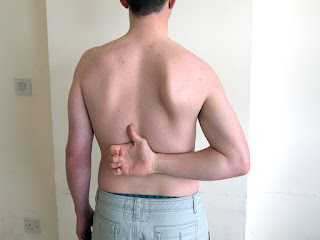 |
| Ref: https://www.bicycling.com/ |
Quadriceps muscle is bi - articular joint muscle of hip and knee. Its function includes straight knee joint and flex hip joint that stretch the lower back, gluteal and hamstring. Normally, tightness of the quadriceps develops knee bending limitation that when bending the knee, the patient will feel tension at the muscle belly.
My physiotherapy experience, I have seen tightness of the proximal quadriceps in IT band syndrome, upper gluteal pain, and low back pain sometimes. If I take care of these cases, I will add on the proximal quadriceps assessment for more information. Mention to anatomy, this muscle can irritate pelvic posture due to the origin of attachment on a part of the pelvic where is AIIS.
 |
| Quadriceps origin (red mark) (Ref: https://compedgept.com/blog/) |
Sometimes, I have found tightness of the proximal quadriceps following tightness of TFL. Perhaps, their origins are very near and they are located like a neighborhood. Sometimes, I have found only one of them gets tight. However, I would like to recommend stretching the proximal quadriceps if it demonstrated tightness. It can help to release rear side pain and improve posture.
 |
| Strong stiffness of proximal quadriceps that cannot straight hip joint from flexion position. |
Previously, I presented the way to stretch quadriceps. I have seen some patients had very strong stiffness of that tissue that would be the threat of recovery. Some of them have done the stretching difficulty. The patients alway compensate i.e. arch lower back or cannot upright hip and torso.
 |
| Arching at lower back to compensate |
I found one tips of proximal quadriceps stretch for strong stiffness as this VIDEO
Exercise #1: Half kneeling with toe stand stretch: the target leg is on the knee with set ankle at neutral. Lean back and pelvic backward slightly without arching the lower back. We need hip joint to be neutral or extension.
Case sample 1
Case triathlon athlete who has got both lateral groin pain after cycling training. The patient denied low back pain and gluteal pain. The muscle length assessment found tightness of both proximal quadriceps and slight tightness of TFL. This case did not has gluteus medius weakness that did not persuade me to think of IT band syndrome. One of my treatment processes was isometric contraction of quadriceps before proximal quadriceps stretching as demonstrated VIDEO.
 |
| Cycling posture demonstrates prolonged hip flexion with prolonged gluteal and lower back stretch (Ref: https://www.giant-bicycles.com/) |
Case sample 2
Case swimmer who has got one side of the upper gluteal pain that was worse pain by crawl stroke and butterfly stroke. The patient did not has low back pain and knee pain. Gluteal muscles got pain from pressing and weakness which was gluteus maximus. The gluteus medius was a normal strength that did not persuade me to think of IT band syndrome. QL and back extensor muscle were not spasms. I almost concluded only inflammation of gluteus maximus muscle, but I have seen slight hip flexion in supine lying. Additionally, the quadriceps muscle mass looked massive that illustrated the groove between ASIS and quadriceps belly.
This groove was only on the pain side and not on the other one. I did more evaluation for quadriceps muscle length, then it showed tightness of the proximal quadriceps. One of my treatment processes was stretching proximal quadriceps and gluteus maximus facilitation. I gave a home program assignment for stretching as demonstrated VIDEO and exercise gluteus maximus.
Case sample 3
Case of a computer office worker who has got one side of upper gluteal pain and neck pain with radiation to the lateral thigh and tibia from forward reaching to put something on the shelf 2 months ago. The patient was treated by medicine, physiotherapy modalities, and stretching of the gluteus and hamstring. Firstly, I considered about piriformis syndrome. The job characteristic is prolonged sitting at the working desk. The standing posture showed a torso shift forward. There was severe pain and hypersensitivity that felt pain at the gluteus maximus, gluteus medius, TFL, and quadriceps. Torso forward bending was limited by pain with a very narrow range. Torso backward bending was limited by worse pain and radiated to the lateral foot. It was not only pain but also numbness on some range of motion that made me think about nerve irritation.
 |
| One sample of stand and reach function in normal life living that can stress to lower back and gluteal (Ref: https://depositphotos.com/) |
I started treatment with a gentle massage on my iliopsoas and quadriceps because firstly my aim was improve posture. It was a good response that pain intensity was decreased significantly. Then I started stretching iliopsoas and proximal quadriceps gradually where pain and numbness free. After the hip extension range increased, I started gluteus maximus facilitation to the hip stability function. Finally, the pain intensity decreased 70 - 80% with improved standing posture. The torso range of motion and all tenderness of gluteal muscle were improved. I gave a home program assignment for stretching as demonstrated VIDEO and exercise gluteus maximus. Moreover, the patients was recommended not to be prolonged sitting because proximal quadriceps may be tight together with prolonged stretch gluteal region. I concluded this case was upper gluteal strain with proximal quadriceps spasm.
 |
| Prone hip extension exercise for strengthen gluteus maximus (Ref: https://www.saintlukeskc.org/) |
The principle to stretch this muscle is the same as the others: stretch to the point where “tightness with pain” or “noticeable tension without pain” will hold at the point for 30 seconds of 3 - 5 reputations following a demonstrated VIDEO.












.jpg)



.jpg)




.jpg)


.jpg)



